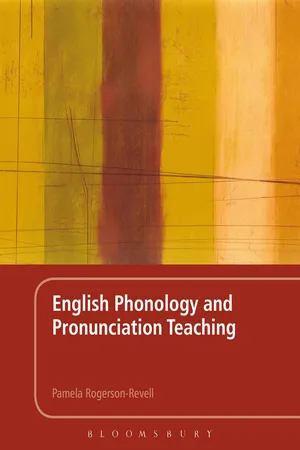Languages & Linguistics
Tone Shift
Tone shift refers to a change in the emotional or expressive quality of language within a piece of writing or speech. It can involve a shift from a serious tone to a humorous one, or from a formal tone to an informal one. Tone shifts can impact the overall mood and meaning of the communication, and are important to consider in linguistic analysis.
Written by Perlego with AI-assistance
Related key terms
1 of 5
3 Key excerpts on "Tone Shift"
- eBook - PDF
- Pamela Rogerson-Revell(Author)
- 2011(Publication Date)
- Continuum(Publisher)
It helps the listener to get a clearer picture of what the speaker intends to mean and fulfills many, overlapping functions including attitudinal, grammatical, discursive and pragmatic. However, there is still much to be learned about how we acquire and use intonation systematically and how, or if, it can be taught to second language learners. Research suggests that intonation is acquired very early in English and many babies can mimic intonation patterns (Peters 1977). Similarly, most children will make a distinction in meaning between the use of falling and rising pitch by the age of two, if not earlier. Jenkins (2000) concludes that this suggests that the L1 intonation system is deeply ingrained at a subconscious level which makes it particularly difficult to modify in terms of learning L2 intonation patterns. English Phonology and Pronunciation Teaching 180 Tone vs intonation languages Pitch variation plays an important role in language by adding meaning in addition to that conveyed by the speech segments or phonemes. The type of meaning that pitch movement conveys varies among languages. In some languages, changing the pitch level (e.g. high, mid, low) or contour (falling or ris-ing) on a particular word can change the lexical meaning. Each word or morpheme has its tone and in suprasegmental analysis the main phonological unit would be the syllable. So, in Mandarin Chinese, for example, ‘ˉma’ with a high level tone means ‘mother’ while ‘ ̗ ma’ with a low rising tone is ‘hemp’ and ‘ ̖ ma’ with a low falling tone is ‘scold’. Such languages are known as tone languages and many of the world’s languages, especially in South East Asia (e.g. Chinese, Thai and Vietnamese) and Africa (e.g. Bantu) are tonal. Most European languages are not tonal although languages such as Serbian, Croatian, Swedish and Norwegian do have a tonal element. In intonation languages like English, tones are only found on a small number of promi-nent syllables in connected speech. - eBook - ePub
- Bruce Hayes, Bruce P. Hayes(Authors)
- 2011(Publication Date)
- Wiley-Blackwell(Publisher)
15 Tone and Intonation This chapter completes our survey of suprasegmental phenomena with tone and intonation. The chapter also covers the system of phrasal stress on which English intonation depends.15.1 The Use of Pitch in Phonology
Pitch can be considered as a purely physical phenomenon: the vocal cords can vibrate faster or slower, resulting acoustically in higher or lower fundamental frequency. Frequency is measured in hertz (Hz, cycles per second), and is easily measured and visualized with pitch-tracking equipment.1All (spoken) languages have pitch and vary it systematically. What varies greatly is how pitch is used in the phonological system. There are basically three types of languages.15.1.1 Tone languages
In a tone language, pitch is used to distinguish words, and must appear in the lexical entries of morphemes, just like phonemic segmental information. As with segmental phonemes, one can often find minimal pairs and other sets for tone.Figure 15.1 shows a minimal quadruplet from Igbo (Benue-Congo, Nigeria). The four words represent the four possibilities that can occur on disyllabic words in a system that has phonemic Low and High tones. In the figure, the accents ( ́, ̀) are the IPA diacritics for high and low tone. Tones are also shown in the way they will be analyzed below, with H(igh) and L(ow) elements linked to them with lines. Above each form is a pitch track, which shows the changes in pitch over time.Phonemic tone in IgboFigure 15.1The pitch tracks show that the phonemic representation of tone is, as always in phonology, an abstraction: the tones are not “sung” in level pitch like musical notes, but have gliding allotones sensitive to the segmental and phrasal environment.Very often, tone languages lack stress; this is apparently true for Igbo. It is also possible for tone and stress to coexist: Bantu languages often have a complex tone system coexisting with a simple penultimate stress pattern. - eBook - PDF
- Alessandro Duranti, Rachel George, Robin Conley Riner(Authors)
- 2023(Publication Date)
- Wiley-Blackwell(Publisher)
It is thus not only that individuals emotionally respond to linguistic shift that would happen anyway. Rather, affect and emotion can be powerful drivers of linguistic shift as well. More than merely providing a context for witnessing affective attachments rent asunder, linguistic shift is, in these ways, a form of social change that forces us to better integrate scales of social analysis. Linguistic shift is always the result of billions of minute decisions made by individual humans in complex interpersonal contexts and scenarios. To better capture the mechanisms behind linguistic shift—and, indeed, behind social change more broadly—we need to move beyond thinking of people’s motivations in exclusively political AFFECT, EMOTION, AND LINGUISTIC SHIFT 359 economic terms. We need to better connect geopolitical contexts and power relations to the minute, everyday decisions that make up shift over time. This is not to say that attending to affect and emotion in linguistic shift is antithetical to attending to the very real political economic factors on which researchers have heretofore focused. On the contrary, attending to affect and emotion in individual experiences, inter- personal encounters, and unlikely “non-serious” genres can reveal greater truths about sociopolitical processes. TWO SCENES FROM LINGUISTIC SHIFT-IN-PROGRESS To see what we can learn by attending to affect and emotion in linguistic shift, I draw here on ethnographic research in the Buryat territories of Russia. In this region, along the Russian-Mongolian border, the Mongolic language Buryat once dominated, even serving as a regional lingua franca. But over the course of 400 years of contact with Russian- speaking fur trappers, exiles, settlers, revolutionaries, and labor migrants, during which Russian has been the language of economic and political power, ethnic Buryats (and non- Buryats who once paid them tribute) have shifted from speaking mostly Buryat to speaking mostly Russian.
Index pages curate the most relevant extracts from our library of academic textbooks. They’ve been created using an in-house natural language model (NLM), each adding context and meaning to key research topics.


